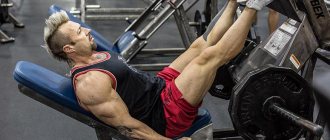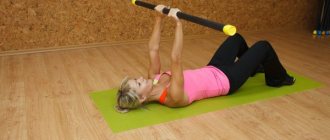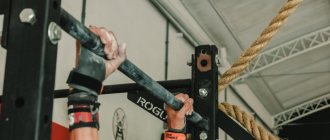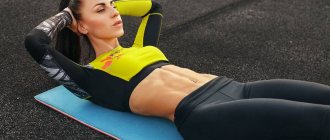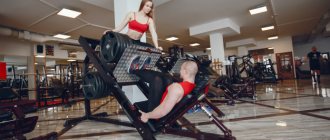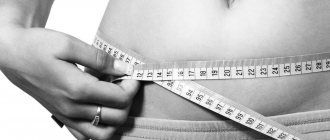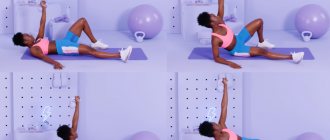© Georgiy — stock.adobe.com
Share:
What you need
- Kettlebells
A kettlebell is an effective, convenient and affordable sports equipment. If it is unlikely that you will be able to work out with a barbell in a small apartment, then exercising with weights at home is a completely acceptable option for independent training. With the help of these equipment, you can effectively pump up all muscle groups and at the same time even successfully diversify your training.
The only possible problem is that for optimal training you will need different weights of equipment. For example, for exercises on the legs and back - 24 or 32 kg, and for shoulders and arms - 8 or 16. Therefore, ideally, you should purchase light and heavy weights (or a pair of both) or collapsible ones.
Next, we will analyze in detail the exercises for each muscle group.
Pectoral muscles
Bench press
If you have a bench, that's great. If this is not available, you can try placing several stools in a row or using another similar support, the main thing is that it stands stable.
In the future, the technique is practically no different from the usual dumbbell bench press:
- Starting position (IP) – lying down, shoulder blades retracted, legs firmly resting on the floor. Hands with weights are straightened and above the chest. Grip - by the handles, the shells hang not on the sides, but towards the side of the head.
- As you inhale, you need to slowly lower your arms, while your elbows go to the sides perpendicular to the body, and do not press against the body. The depth should be comfortable, depends on your stretching, no need to do it through pain.
- As you exhale, use a powerful force from your pectoral muscles to press the weights upward. It is better not to straighten your elbows all the way - this way your chest will be tense throughout the entire approach.
If you only have one kettlebell, you can do the press either with your hands alternately, or grab it by the bottom with both hands at once. It all depends on its weight and your strength indicators.
Floor press
If you don't have anything to make a bench out of, the floor press is an alternative. The main difference here will be a smaller amplitude, which slightly reduces the effectiveness of the exercise. The technique is similar, only for better support it is better to bend your legs at the knees:
© ifitos2013 — stock.adobe.com
This exercise can also be performed with one hand:
© giancarlo501 — stock.adobe.com
Another interesting option is to press two weights on the floor alternately. You pick up both projectiles at once, but do not squeeze them together, but first with your left hand, then with your right. In this case, the body can be slightly raised following the working hand:
Kettlebell push-ups
This type of push-up increases the range of motion, which allows you to better stretch and work your chest.
The technique is as follows:
- Place two weights wider than shoulder-width apart. Their handles should be parallel to the body.
- Take a lying position, in which your hands clasp the handles of the implements.
- As you inhale, lower yourself as low as your stretch allows.
- As you exhale, rise to the starting position with a powerful movement. It is better not to straighten your arms completely; immediately proceed to the next repetition.
© chrisgraphics — stock.adobe.com
If you are a beginner and are afraid of not being able to hold the kettlebells with this grip, use the following option:
© nastia1983 — stock.adobe.com
Option for advanced athletes - one-arm push-ups:
© nastia1983 — stock.adobe.com
Pullover
This is an exercise that works the pectoral muscles, triceps and lats. Moreover, the load is distributed in this order. One shell will be enough.
It is best to perform it on a straight bench; a chair or stool is also suitable here, since here support is needed only for the upper back.
In the process of moving your arms back, you do not need to bend them so that the load does not go into the triceps. Try to perform both lifting and lowering slowly and under control, concentrating on the chest muscles.
Approximate training program with the apparatus
- Cardio on the treadmill or jumping rope – 15 minutes.
- Side bent kettlebell row – 3 sets of 10 reps.
- Lateral crunches with kettlebell – 3 sets of 15 reps.
- Pulling the weights from a half squat diagonally - 3 repetitions of 10 repetitions.
- Leg raises lying on the floor (without weights) – 2 repetitions as many times as possible.
- Cardio on a treadmill or jogging in place – 10 minutes.
Important! Given the high intensity of the above training program, its implementation is recommended for people with at least an average level of physical fitness.
Back
Deadlift
Classic deadlifts can be performed with either one or two kettlebells. This is a powerful basic exercise that, in addition to the back muscles, actively engages the quadriceps.
Technique with one kettlebell:
- Stand in front of the apparatus - it is between your legs at the level of your toes, your legs themselves are shoulder-width apart.
- Squat forward and grasp the handle of the kettlebell with both hands.
- By simultaneously extending your legs and straightening your back, rise to the starting position. There is no need to bend backwards - just stand straight. The most important thing is that your back should not be hunched in the lumbar and thoracic regions throughout the entire movement.
- Perform the next repetition by lowering the apparatus toward the floor, but without touching it.
© Mihai Blanaru — stock.adobe.com
In the case of two weights (to increase the working weight), the technique is almost the same. Only in this case they will stand on the sides of the legs:
© antic — stock.adobe.com
Bent-over row
Here you can also come up with several options for implementation. Classic - one-arm deadlift. You can lean on a bench, sofa or any other similar surface (preferably not too soft).
The technique is as follows:
- Stand to the side of the support, for example, to the right of it. Lean on it with your left hand and left bent leg. Place your other leg back and slightly to the side, bend it slightly at the knee, the support should be secure.
- Take the weight with your right hand. Straighten your body - it should be parallel to the floor. The hand with the weight hangs down. This is the starting position.
- As you exhale, using the efforts of your back muscles, pull the projectile to your belt. In this case, the elbow runs along the body, almost pressed against it. At the top point, you can turn around a little so that the amplitude of the movement is as large as possible.
- As you inhale, lower the projectile down as far as possible without rotating your body, while properly stretching your lats, and immediately begin a new rise.
- Then the same must be repeated for the other hand.
If you do not have any suitable support, you can perform the exercise without it. To do this, you will need to put your left leg forward, as in a lunge, rest your left hand on it and bend down, but not to parallel with the floor, but a little higher:
If the kettlebell is too heavy to pull with one hand, you can perform the lift with both hands at once - in this case, the movement will be similar to the bent-over row of a barbell to the waist. In the same way, you can pull two projectiles at once.
Kettlebell Snatch Push-Up
This is a difficult exercise, so don't make the mistake of picking up a heavy instrument right away. It's better to start small, take a light weight. Believe me, the exercise will not seem easy to you if you are trying it for the first time. However, the weight of the kettlebell should be optimal so that during push-ups the weight doesn’t slip out from under your hands, you fall face down on the floor and hurt your wrist. Be careful!
1. The first point is push-ups. But not simple ones. Usually your hands were fixed on the floor, and now the horns of the weight, which you will turn its massive part towards your face, will serve as support. Make sure to place the body exactly along the line. Tighten your buttocks and abdominal muscles. Do push-ups.
2. Instead of repeating push-ups, move into a squat position as you lift your torso. At the same time, move the weight between your legs.
3. Straighten your legs and simultaneously jerk the kettlebell. Hold it with both hands and lift it slightly above head level with your arms outstretched. You don't have to be completely standing. The legs may be slightly bent at the knees.
4. Return the kettlebell back to the push-up position. Repeat the exercise complex 10 times. This will tone your abs, tone your butt and strengthen your back!
Turn combo exercises into a workout!
This list of activities I have invented can be turned into a full-fledged workout. To do this, repeat each exercise 10 times, as I wrote in all the lists. Then repeat the entire cycle of 6 sessions three times. You can change the sequence of training exercises, but it is better not to reduce the number - 10 approaches is the ideal number to start with. It has been tested several times: you will repeat what is described at least 2 times a week and you will not recognize yourself after 3 months. But the result will not come on its own. Since you have read to the end, you have the desire to develop. So, let's get started. Now.
More interesting on the topic:
– CrossFit at home: 5 workout programs at home
– Functional training with BOSU
– Body drying for girls
– How to Lose Weight: A Guide to Weight Loss
Triceps
Neutral grip kettlebell press
This exercise is similar to the regular bench press discussed above. However, the emphasis here is on the triceps due to a different grip - the shells need to be taken with a neutral grip, that is, the palms will face each other, and the weights will hang down to the sides. There is also a difference in movement - when lowering, you should not spread your elbows to the sides, but keep them as close to the body as possible. At the top point, fully extend your arms. You can perform it either on a bench (preferred option) or on the floor.
If there is only one projectile, you can press it with both hands at once, holding the bottom and not forgetting about the correct trajectory of the elbows:
Arm extensions from behind the head
An alternative to the French press. This exercise is even easier to perform with a kettlebell than with dumbbells, since it is more convenient to hold.
The technique is as follows:
- We sit on a bench, sofa or chair without a high back. Raise the projectile above your head in any convenient way and hold it with both hands by the handle so that it hangs back.
- As you inhale, gently lower it down, bending your arms. Make sure that your elbows do not move too far to the sides. Also be careful not to hit your head.
- As you exhale, extend your arms to the starting position.
The exercise can be performed while standing, but it is more convenient to maintain balance while sitting.
© Photocreo Bednarek — stock.adobe.com
If it’s too easy for you, you can do extensions with one hand:
© Ocskay Mark — stock.adobe.com
Kettlebell push-ups with narrow arms
Push-ups can also be done by focusing on the triceps rather than the pecs. To do this, we place the apparatus shoulder-width apart, and when lowering, we do not spread our elbows, but keep them as close to the body as possible. Extend your elbows to the end in each repetition.
© gpointstudio — stock.adobe.com
Kettlebell Bench Press
With this kettlebell fitness exercise you can perfectly strengthen your pectoral muscles. To perform it, you need to lie on the floor, spreading your legs to shoulder width. Experienced weight lifters press two weights at once, but beginners are better off pushing them one at a time. It is recommended to start with one projectile. In this case, we move our free hand slightly to the side. We place the weight on the bend of the elbow of the working arm. The elbow itself is pressed to the body.
At the moment of the push, the hand with the weight turns with the palm towards the legs. We return the projectile to its original position in the reverse order. You should also remember that the weight is pushed as you exhale.
The number of repetitions depends on the weight of the projectile. With weights from 16 kg, you can train according to the classic scheme: 5 sets of 5 repetitions. With a weight of 8 kg, the number of repetitions will be twice as many.
Biceps
Arm curls
As part of home workouts, this is the main biceps exercise. It is performed as follows:
- Stand straight, feet shoulder-width apart, exercises in your arms.
- There are options for grip. The first is a neutral grip, with your palms facing each other. In this case, when lifting, you need to supinate the hand - turn it away from the body so that the weight hangs in front of the hand. The second option is to initially take such a grip so that your palms point away from the body, and do not change the position of your hands while lifting. Both options are good, it is recommended to alternate them from workout to workout.
- As you exhale, bend both arms, lifting the exercises to your shoulders (you can lift them one at a time, but this will give the biceps time to rest). Make sure not to help by rocking the body, and also do not move your elbows forward - they must be fixed. If it doesn’t work, then you took too much weight and you need to lower it or lift one weight with both hands at once.
- As you inhale, slowly lower the exercises, but do not fully extend your arms; keep your biceps under load the entire time.
© nastia1983 — stock.adobe.com
Option with lifting one weight with two hands:
© Nomad_Soul — stock.adobe.com
You can also do the exercise first with one hand (all repetitions), and then with the second:
© Nomad_Soul — stock.adobe.com
Concentrated curls
Even the possibility of cheating is excluded here; the biceps are worked in isolation, so the working weight will be slightly less.
The technique is:
- Sit on any comfortable support, spread your legs wide and firmly rest them on the floor.
- Take the weight with one hand, rest its elbow on the thigh of the same leg.
- As you exhale, lift the projectile by bending your arm. Don't lift your elbow from your hip.
- As you inhale, lower your arm under control without fully extending it, and immediately do the next repetition.
- Do the exercise for your second hand as well.
© akhenatonimages — stock.adobe.com
Reverse grip curls
This option works the brachialis (located under the biceps) and brachioradialis muscles. Their hypertrophy is no less important for large arm volumes, which is why curls with a reverse or hammer grip must be included in the program.
The technique is identical to regular curls, only this time the grip will be straight, that is, the palms are facing back. This will make it harder to lift the shells, so take less weight. You can perform it with both hands at once, or alternately with each.
© ifitos2013 — stock.adobe.com
"Hammers"
These are the same bends, only the grip should be neutral throughout the entire exercise - palms facing each other:
© ifitos2013 — stock.adobe.com
Workout for Beginners
Kettlebell training can be done both at home and in the gym. However, in any case, at the first stage they will not be as easy to perform as it might seem at first glance
Therefore, it is very important to choose the right weight; of course, exercises with a kettlebell of 16 kg, 20 kg, 24 or more are not suitable for beginners. Start with the smallest, because even if it seems to you that your muscles are strong, your ligaments and tendons may not be able to withstand the load if you are not used to it.
Kettlebell push
This is a good multi-joint functional exercise that allows you to train all muscles - legs, buttocks, arms, shoulders.
Technique:
Stand up straight, spread your legs wide apart. Bend your knees, squat down and grab the weight with both hands. Straighten up. Raise it quickly up to shoulder level (arms should be straight throughout the exercise) by pushing with your hips. Lower the kettlebell down while squatting slightly
With a second swing, lift it up again, etc.
It is very important to use stabilizer muscles to control the position of the body
A similar exercise can be performed with one hand.
Remember that you should start performing each exercise with one repetition. And if you are doing an exercise with a kettlebell with one arm, then first perform all the approaches on one arm, and only after that proceed to the second.
After this, you can perform swings with one hand, but with an interception in the other hand at the lowest point.
You can increase the weight when you can perform a total of 100 swings in 5 minutes. You can exercise 5-6 times a week. If you have a basic fullbody or split training program, then kettlebell training can be performed 1-2 times a week.
Be sure to do a good warm-up before exercise. Do not forget that ligaments and tendons receive special stress, so performing on cold muscles is extremely dangerous.
Kettlebell press
This exercise perfectly works the deltoid muscles and partially loads the leg muscles. It is easy to implement and affordable, so you can freely perform it at home. This kettlebell exercise can be performed with one or two hands.
Technique:
- Stand up straight, take the weight in your hand and pull it to your shoulder.
- Do a half squat and, as if pushing with your legs, raise your arm up.
- As you straighten your arm up, make sure that your hand turns outward.
Kettlebell row to chest
This exercise also allows you to work out the belt of the upper and lower extremities; it is also easy to perform at home.
Technique:
- Stand straight, legs wide apart. Squat down and grab the weight with both hands.
- Straighten your legs and at the same time pull the weight to your chest, bending your elbows, lower it down again and squat.
Sumo squats with kettlebell
This exercise is performed technically in the same way as a regular sumo squat. The only difference is that the projectile is held in the hands. Namely, you need to pull the kettlebell to your chest and grab its handle with both hands. It is necessary to squat while keeping your back straight and as deep as possible. If your ankle is tight, place a book or a block under your heels.
Turkish Rise
Technique:
- Lie on your back, on the right side, grab the weight with your right hand and straighten it above you. Bend your right leg at the knee.
- Keeping your right arm straight and above you, begin to rise up using your left arm and right leg.
- Having reached a sitting position, lean on your left palm and right foot, lift your pelvis up and move your left leg back, resting it on your knee.
- Remove your left hand and stand up, straightening both legs.
It is necessary to perform the same movements, but only in reverse order.
Throughout the entire exercise, you must keep your right arm straight above you. Repeat the same with your left hand.
Other exercises
deadlift or deadlift lying lunge
Training with kettlebells is very convenient, as it allows you to hold the apparatus in a way that is comfortable for you, which is impossible to do with a barbell or even dumbbells.
Shoulders
Standing Kettlebell Press
A basic exercise that uses all three deltoid bundles, although the main load falls on the front one. Can be performed with both hands at once or with one. The technique is as follows:
- Hop the weights (or kettlebell) from the floor onto your shoulders in any convenient manner. Stand straight, feet shoulder-width apart, no need to bend them.
- As you exhale, using the deltoid force, straighten your arms with the apparatus above your head, without sitting down or arching your back. The movement should be carried out only in the shoulder and elbow joints - this is the main difference between the bench press and the shvung.
- As you inhale, slowly lower the weights back to your shoulders.
© Mihai Blanaru — stock.adobe.com
There is a slightly more complicated option - bench press one kettlebell, holding it by the bottom. Here, more effort will be required to keep the projectile in balance and more stabilizer muscles will be activated. You need to take a little less weight.
© ifitos2013 — stock.adobe.com
Chin pull
This is also a basic exercise, here the emphasis of the load can be shifted to the front or middle beam:
- If you hold one kettlebell with both hands and pull it toward your upper chest, you'll work your front delts and traps.
© ifitos2013 — stock.adobe.com
- If you take two projectiles and lift them at a distance from each other (approximately shoulder width), the middle beams work. In this case, the lifting height will be slightly less.
These options are an alternative to pulling the barbell to the chin with a narrow and wide grip, respectively.
Kettlebell swings
This exercise is isolated and absolutely identical to dumbbell swings. You can also perform forward swings on the front beam, sideways swings on the middle beam, and sideways bending swings on the back beam. An important point - here you will need lighter weights, about 8 kg. Only sufficiently trained athletes can perform such movements cleanly even with 16 kg.
The only option when you can take one projectile with both hands is to swing forward:
© Vitaly Sova — stock.adobe.com
How to choose the right kettlebell?
In addition to the familiar standard round-shaped weights used by professionals, you can find prefabricated and bulk equipment in sports stores. The first ones consist of several separate plates, by changing the number of which you can vary the weight of the projectile. This type of kettlebell is the most economical, as it allows you to increase the load without purchasing additional equipment. But you should pay special attention to the quality of such a projectile so that it does not crumble over your head.
Bulk weights are hollow from the inside and filled with sand. Their weight can also be changed, but not everyone wants to constantly weigh and pour sand.
Modern projectiles also differ in shape. They can be square, disc-shaped and even in the shape of a human head. It is also possible to have two handles at once. But if you need a universal apparatus with which you can do all types of exercises, then preference should be given to the classic core with a bow. Moreover, the weight should be made of metal, not plastic, since in the latter case the center of gravity shifts.
Before purchasing, be sure to try lifting the projectile up to evaluate the convenience of the bow. When sagging down, the weight should be located on the forearm. If it stops at the wrist, you need to select a projectile with a greater distance from the core to the bow. In non-professional equipment, the arms may vary in thickness. If it is too thick, the projectile will not grip properly and the risk of injury will increase. For example, when performing exercises with kettlebells on the shoulders, an incorrect grip can lead to damage to the shoulder joint.
Legs
Goblet Squats
The first type of squats focuses on the quadriceps. Also, a good load goes to the gluteal muscles. The hamstrings, calves, spinal erectors and abs work as stabilizers.
The technique is:
- Take the kettlebell by the handle on your sides with both hands, stand straight, feet slightly wider than shoulder-width apart, toes pointing slightly to the sides.
- Without changing the angle of your back or hunching, squat so that your thighs form an acute angle with your shins, that is, below parallel. At the same time, try not to let your knees go ahead of your toes.
- Get into the starting position, do not bring your knees together when lifting. Do not straighten your legs all the way; begin the next repetition immediately.
A variation of this exercise can be called a squat with a kettlebell on outstretched arms. Here it will most likely be easier for you to catch your balance, but it is more difficult to hold the projectile - only the front deltoids work on this.
© georgerudy — stock.adobe.com
Experienced athletes can perform the movement with two kettlebells, thus increasing the load on the legs.
Plie squats
Here the load shifts to the adductor muscles of the thigh (inner part), as well as the gluteal muscles. The quadriceps also works, but less.
Technique:
- Place your feet significantly wider than your shoulders, and also turn your toes to the sides. The projectile is in your hands down, it will be easier to hold it here.
- As you inhale, lower yourself slowly, as if sitting on a chair. At the same time, your knees point in the same direction as your socks, do not bring them together.
- Lower yourself to a comfortable depth and, as you exhale, begin to rise, straightening your knee and hip joints. Also make sure that your back does not round and your knees do not go past your toes.
© Vitaly Sova — stock.adobe.com
To make the exercise more difficult, you can hold a weight in each hand.
Single leg squats
Another name for the exercise is “pistol.” In this case, it is performed with weights - a kettlebell, which must be held with arms outstretched forward. Not suitable for a beginner, but for more experienced athletes it is an excellent movement that allows you to pump up the muscles of the legs and buttocks, as well as develop coordination and dexterity.
© ifitos2013 — stock.adobe.com
To practice the exercise, you first need to learn how to correctly perform a regular squat, then on one leg without weights (you can sit on a sofa or hold onto a support with one hand) and only then proceed to the most difficult option.
Lunges with kettlebells
Lunges are a versatile exercise for the lower body. The quadriceps, hamstrings and glutes work here. At the same time, the front part of the thigh works more with a narrow and medium step, and the back and buttocks work more with a wide step.
In general, the technique is as follows:
- Take the apparatus in your hands, stand straight with your feet together.
- Take a step forward with your left foot, lower yourself down until your right knee almost touches the floor. It is not necessary to touch - just go down to the greatest depth. In this case, the angle between the thigh and shin of both legs should be 90 degrees.
- Return to the starting position and lunge with your right leg.
© djile — stock.adobe.com
Kettlebells can also be held overhead - here the shoulders and triceps will work statically, plus in this option it is a little more difficult to maintain balance, which will lead to the connection of more different stabilizer muscles.
© ifitos2013 — stock.adobe.com
If you only have one kettlebell, you can do each leg separately, either squeezing the apparatus with the same hand each time you lower it, or constantly holding it at the top.
Romanian deadlift
Basic exercise for the hamstrings and glutes. Can be performed with one weight or two - depends on physical fitness.
The technique is as follows:
- Stand straight, feet shoulder-width apart, slightly bent, the apparatus hanging in your lowered hands.
- As you inhale, lean forward, while the movement occurs by moving the pelvis back. The angle in the legs does not change. The depth of the bend depends on your stretch. At the bottom point you should feel your hamstrings stretch. The back should never be rounded. Squeeze your shoulder blades and watch the position of your back. If you start to lean your shoulders forward or sag in your lower back, reduce the weight.
- As you exhale, return to the starting position. To emphasize the load on the muscles of the legs and buttocks, straighten your torso not by moving your body upward, but as if pushing from the floor with your legs and pushing your pelvis forward.
© nazarovsergey — stock.adobe.com
Ready-made kettlebell lesson plans: a simple program
If you are going to work not only with kettlebells, increasing strength and endurance, but also to build muscle mass, then it is better to do no more than 10-15 repetitions with a 16-kilogram kettlebell. In other cases, you can increase the number of repetitions to 12-20.
Provided you work with such a projectile once a week, alternating with other workouts, you can perform the complex proposed below at a time, with one approach. Provided you break it down into complexes and perform them on different days, do 2-3 approaches.
For the upper body
- Rotation of the weight.
- Bench press
- Traction.
- Casting
- Pull up to the chest.
- Push-ups.
- Triceps pullover.
For the lower body
- Squat with a kettlebell.
- Squat with legs raised.
- Single leg deadlift.
- Back lunges with throwing.
- Jump squats.
- Combined squats.
On the press
- Mill.
- Russian twist.
- Horizontal running.
- Rotation of the weight around the body.
- Lifting the body.
- Turkish rise.
For the whole body
- Squat with a raised kettlebell.
- One hand push.
- Deadlift.
- Swing.
- Side lunge with press.
- Squats + bicep curls.
- Turkish rise.
Press
All abdominal exercises with kettlebells are not suitable for beginners, who first need to learn how to perform them correctly with their own weight and only then gradually increase them.
Crunches
This is a classic version of crunches on the floor, only with additional weights. It is most convenient to hold the projectile on the chest with two hands. Don’t forget that when doing crunches, you don’t need to lift your lower back off the floor—only the shoulder girdle, while rounding your spine and straining your abs.
© ifitos2013 — stock.adobe.com
Reverse crunches
This is a heavier version of reverse crunches - when you do not pull your body towards your stationary legs, but, on the contrary, raise your bent legs, lift your buttocks and lift them up, straining your lower abs.
Here you can hold the weights with your arms outstretched in front of you:
© ifitos2013 — stock.adobe.com
Side plank
Here the oblique abdominal muscles work statically. The kettlebell can be held with your free hand at the shoulder or on your arm extended upward. You can stand in the plank either on your elbow or on a straight arm.
© ifitos2013 — stock.adobe.com
Corner on kettlebells
An excellent exercise for the rectus abdominis muscle. The technique is:
- Place the implements shoulder-width apart so that when you lean on them, your arms are perpendicular to the floor.
- Sit between the apparatus, stretch your legs forward, grasp the handles of the weights, straighten your arms. The pelvis should lift off the floor.
- Raise your legs up so that an angle of 90 degrees is formed between them and the body, and hold for as long as possible.
© grki — stock.adobe.com
Selection of kettlebell mass
A kettlebell is a projectile that has an unregulated weight. This is considered its main drawback.
In total, there are several options for weights on sale - in “steps” of eight or four kilograms.
Some manufacturers produce such equipment with a difference in weight of only two kilograms.
However, the most common are shells weighing 8, 16, 24 and 32 kilograms.
An indicator that the weight is ideal for you is that you can lift the weight 5-7 times without feeling very tired or tense in your muscles and joints.
When the number of repetitions reaches 30-35, this is a sure sign that it’s time to move on to a heavier weight apparatus.
On average, a kettlebell for men weighs 16 kilograms. For women, the range of values is much greater, and it depends on the level of training, body weight and the percentage of muscle tissue in the body.
Most often, non-professional athletes train with equipment weighing from 6 to 12 kilograms.
Complex exercises
Russian kettlebell swings
Russian swings are a popular CrossFit exercise that came from kettlebell lifting, where it is an auxiliary exercise. It's similar to the standing front delt swing, but the movement itself is driven more by the hips and back rather than the shoulders and arms.
© studioloco — stock.adobe.com
There are several options for performing Russian swings, and they can also be done with two kettlebells. The exercise develops well the muscles of the shoulder girdle, legs, lower back, and explosive strength of the lower body. A good option for beginners, who will then have to learn the technique of more complex movements - pushes, pushes, pulls, etc.
Turkish get up with kettlebell
The Turkish get up is an example of a functional and efficient movement. The Turkish get-up works every muscle in your body. This exercise also works on shoulder mobility: you'll be sure to stabilize your shoulder by rotating it as you perform the task.
Pay attention to an important nuance that ensures the purity of the Turkish get-up: when you stand up, the body must be fully straightened, and at the end and at the beginning of the exercise the projectile must touch the ground.
© Mihai Blanaru — stock.adobe.com
Kettlebell push
An exercise similar to the standing press, but with assistance from the legs. Also used in kettlebell lifting and crossfit. Since the clean and jerk is easier than the press due to a different technique, the weight here must be greater, which leads to an increased risk of injury. Be careful when increasing the working weight.
Short cycle push technique:
- Throw the weight over your shoulder with a jerk from the floor.
- Perform a push - squat down a little and immediately straighten up, while sharply throwing the weight up.
- Hold in the top position for a second, then return the projectile to your shoulder, lightly cushioning it with your knees.
The exercise can also be performed with two kettlebells.
Kettlebell Snatch
This exercise also comes from kettlebell lifting. The shoulders, trapezius, and spinal extensors work actively here; the legs are also involved, but less than when performing, for example, a kettlebell jerk into a squat position.
The technique is as follows:
- Place the weight in front of you, feet shoulder-width apart.
- Lean towards the apparatus, while bending your legs slightly. Do not round your back, keep a bend in your lower back throughout the entire exercise.
- Take the weight, make a small swing back and immediately begin lifting it up, helping with your body and pelvis. The arm should not bend or straighten - all movement occurs due to the inertia and efforts of the deltoid and trapezius.
- At the top point, fixate for a second and begin lowering. There is no need to put it on the floor - swing back and rise again.
© Mihai Blanaru — stock.adobe.com
Emissions (thrusters)
Kettlebell throws are a goblet squat, squeezing the weight over your head at the same time as lifting.
The projectile in the starting position must be held with both hands on the sides of the handle at chest level. Feet are shoulder-width apart, toes slightly pointed to the sides. Then the usual bending of the legs occurs during squats until the thighs are parallel to the floor (or slightly lower) and further lifting, while simultaneously straightening the arms along with the weight. Do not forget that you need to keep your back straight, do not hunch or bend over.
Squat Pulldown
A combination of goblet squats and kettlebell rows to the chin. This exercise allows you to work your quadriceps, deltoids and trapezius.
Technique:
- Stand with your feet shoulder-width apart and grab the kettlebell by the handle with both hands.
- Keeping your back straight, do a normal squat.
- As you exhale, begin to stand up powerfully, while the weight, by inertia, will continue to go up after straightening your legs. Using the force of the deltoids and trapezius, continue its movement to the upper chest. The elbows should go up, above the level of the hands.
- Lower your arms and start a new repetition.
© ifitos2013 — stock.adobe.com
Farmer's Walk
This exercise develops all the leg muscles, strengthens the grip, and the abdominal and forearm muscles work well here. The technique is simple - pick up two heavy weights and slowly walk forward in short steps. At the same time, do not round your shoulders, keep your back straight, and squeeze your shoulder blades together.
If you have absolutely no space, you can simply develop your grip and forearm muscles by simply holding the implements in place. A more advanced level is to increase the thickness of the handle, for example, by wrapping a towel around it.
© kltobias — stock.adobe.com
Much more could be said about each of the exercises described, and by no means should the above be taken as a complete guide. Consider this information as the start of a new approach to your training.
Kettlebell overhead push
I call this exercise the king of kettlebell fitness because it demonstrates the power of the entire body. In the classic version, it is performed with two weights, but for beginners it is better to train with one. The most interesting thing is that the weight is not thrown up by the hand - it only guides the projectile and helps it reach the top point. The main work is done by the legs and chest.
If the starting position is correct, then this is already half the success. Therefore, the kettlebell, taken with a “toward” grip, should rest on the chest and forearm, and not on the shoulder. While performing the exercise, you need to squat down a little to get the necessary acceleration for the push. For a pro, it’s enough to sit down just 5 centimeters. For beginners you can go below. The movement is forward and upward, that is, the weight is pushed mostly by the chest, and the hand only helps slightly.
The weight is brought to the top point behind the head. In this case, the body, from the hand to the heels, should form one straight line. The projectile must be returned to its original position carefully, extinguishing the force of inertia. To do this, firstly, we perform an upward movement with the chest, as in a jerk. And then we do a small squat, gently taking the weight to the chest. This will avoid serious injury.
The number of repetitions is not standardized. At competitions, athletes perform this exercise with kettlebells for 10 minutes, demonstrating their maximum strength.
Training programs with weights at home
For men
We will analyze two programs - for beginners and more experienced athletes. It is assumed that you have at least two kettlebells of the same weight. Ideally, there should be more of them (of different weights) or collapsible.
So, a complex for beginners, compiled in the fullbadi style - at each training session the same thing is done and all the muscles are worked out:
| Exercise with kettlebells | Approaches | Repetitions |
| Goblet Squats | 4 | 10-12 |
| Romanian deadlift | 4 | 10-12 |
| Push-ups with wide arms | 5 | 12-20 |
| Bent-over one-arm row to the waist | 4 | 10-12 |
| One-arm standing press | 4 | 10-12 |
| Chin row with two weights (if too heavy, then one) | 4 | 10-12 |
You need to do this for several months. Exactly how much is individual. Some people need six months, while others will significantly increase their working weights even after two months and will no longer have time to recover.
In the future, you need to switch to split. It can also be taken by more experienced athletes who have to train at home. Here we use the classic division into synergistic muscle groups - chest + triceps, back + biceps and legs + shoulders.
| Day 1 – Chest and Triceps | ||
| Kettlebell exercise | Approaches | Repetitions |
| Bench press on a bench or floor | 4 | 10-12 |
| Push-ups with wide arms | 4 | 15-20 |
| Pullover | 3 | 10-12 |
| Narrow push-ups | 4 | 15-20 |
| Sitting overhead extension with two arms | 3 | 12-15 |
| Day 2 – back, biceps, abs | ||
| Exercise | Approaches | Repetitions |
| Deadlift | 4 | 10-12 |
| Bent-over one-arm row to the waist | 4 | 10-12 |
| Standing two-arm curls | 4 | 10-12 |
| Standing hammer curls | 3 | 10-12 |
| Crunches | 3 | 10-15 |
| Reverse crunches | 3 | 10-15 |
| Day 3 – legs and shoulders | ||
| Exercise | Approaches | Repetitions |
| Lunges with kettlebells in lowered hands | 4 | 10-12 |
| Romanian deadlift | 4 | 10-12 |
| Squat Pulldown | 4 | 12-15 |
| One-arm standing press | 4 | 10-12 |
| Swing to the sides | 4 | 12-15 |
| Bent-over swings to the sides | 4 | 12-15 |
Preparatory stage for exercises with a 16 kg kettlebell
This type of exercise is designed to effectively work out almost all muscle groups. They comprehensively develop endurance, functional strength, and agility. At the same time, weights will provide not only strength, but also cardio. This simple exercise will significantly strengthen your muscles, help you build a beautiful profile, and also burn excess fat.
Kettlebell lifting should not be confused with muscle building exercises. Such training is aimed more at movement, strength, flexibility, and not at building muscles. Therefore, growth cannot be expected. But weights will definitely help to “draw” the relief significantly.
Strengthening your hands
Without prior preparation, it is better not to try to perform complexes with kettlebells, especially heavy ones. Weak arms, hands, forearms and an insecure grip can lead to unexpected tendon injuries, muscle tears and ligament tears. In everyday life, such simple activities as chopping wood, hand washing, working with a two-handed saw, working with a shovel, rake, pitchfork and crowbar are good for strengthening your hands. Additionally, other sports target the appropriate muscles.
- Rowing.
- Struggle.
- Fencing.
- Gymnastics.
- Biathlon.
- Acrobatics.
- Workout.
- Rock climbing and mountaineering.
- Arm wrestling.
If you have done something similar before, then most likely no preparation will be required. But if not, you should first do push-ups, pull-ups, and deadlifts to strengthen the necessary muscles.
General Tips
- There are two types of weights: solid and prefabricated. The first already have a certain weight ahead of time, and in the second case you can independently adjust it by removing or adding parts of the projectile.
- To avoid injury, you need to start with light weights. Choose a 4, 6 or 8 kg kettlebell. Practice with them. Once you understand the principle and study the technique, you can move on to more serious weights.
- Keep in mind the unspoken rule: the more muscles the exercise you choose covers, the heavier the equipment you can use to perform it.
- Always start your workout with a good warm-up stretching exercise.
Any set of exercises with a kettlebell is much heavier and more intense than any exercise with a barbell or dumbbells. Therefore, you need to warm up before training more carefully, thoughtfully and attentively.
Haven't acquired a shell yet? It's time!
